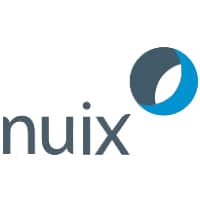 By Alex Chatzistamatis, [1] Principal Solutions Consultant for Legal Futures’ Associates Nuix [2]
By Alex Chatzistamatis, [1] Principal Solutions Consultant for Legal Futures’ Associates Nuix [2]
Now that we’ve covered collections [3]—what I believe is a foundational component to an unstructured data solution—I think it’s time to focus on easily the most important requirement: processing.
Continuing with the concept of building a structure (haha, see what I did there?) one could argue that processing is the frame which everything else is ultimately built around. As I’m sure most of you reading this are aware, processing is a make or break stage. The key thing to remember is your processing tool is only as good as the data you plan to consume, regardless of how narrow or broad your scope may be.
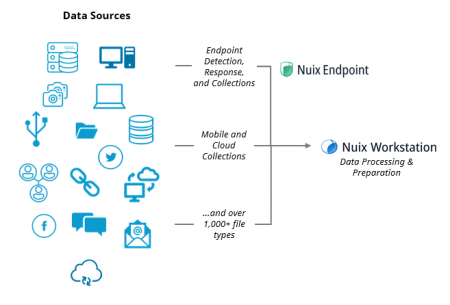
Frankenstein Processing
As I discussed in Part 2 about collections, processing is one of the other steps that can suffer from the Frankenstein effect—various technology components being used to achieve the same result. Even though I’ve seen this time and time again, it still shocks me that many technologists believe there’s no immediate solution for ‘Frankensteined’ technology.
During a recent consultation, I ran out of fingers counting the number of separate tools the organization was using, each being a point solution for a specific data type. Within a few minutes of discussing some of the capabilities that Nuix processing has to offer, the client was blown away with the variety of data that Nuix can process, regardless of total volume, with unmatched velocity, thus proving there IS a better way.
Our processing ‘way’
Some of the most common requirements my clients have when trying to address their processing challenges include:
- Consolidating processing tools in order to do ‘more with less’
- Replacing multiple internal or external workflows with a single platform to reduce TCO
- More functionality to handle disparate data types (including forensic images, emails, logs, cloud data, and more)
- Scalability to meet the demand of growing data volumes.
Of course, this is just scratching the surface, but the Nuix Engine is up for the challenge. The end-to-end Nuix platform is an extremely powerful solution for organizations, but the unique and extensible Nuix Engine is the driving force that makes it all possible.
The Nuix Engine enables endless possibilities including the ability to:
- Gain one window into all the data in a single location where you can use advanced search, culling, and filtering capabilities to understand the content and its context to make informed decisions
- Scale to the largest data volumes, no matter the size of the data set; we even can you let begin working immediately while data is processing, saving you time and effort
- Include all possible content and metadata across thousands of different file types, better known as the Ten Dimensions of Data [4]
- Provide flexible workflows with multiple deployment options, extensible APIs, and unique workflows that help maximize productivity.
Now, allow me to geek out a bit and highlight some of the additional benefits Nuix processing can provide an organization:
- Native support for over 1,000+ different file types with a growing list of supported file types each release
- Built-in, API-based connectors for Microsoft 365 and Amazon S3, among many others
- Extract text and metadata from items, making both easily searchable
- Expanding contents of containers (PSTs, ZIPs, E01s, and more…)
- Providing granular control over the depth of extractions.
Taking on the breadth of your data
Take a minute to review the list of file types below. That’s right … Nuix can consume all these different data sources at unparalleled speeds, all while making the data fully searchable from a single pane of glass!
Imagine being able to combine data from endpoints, DLPs, web servers, disk images, user email, mobile device, and chat data from a single location. Pretty cool, huh?
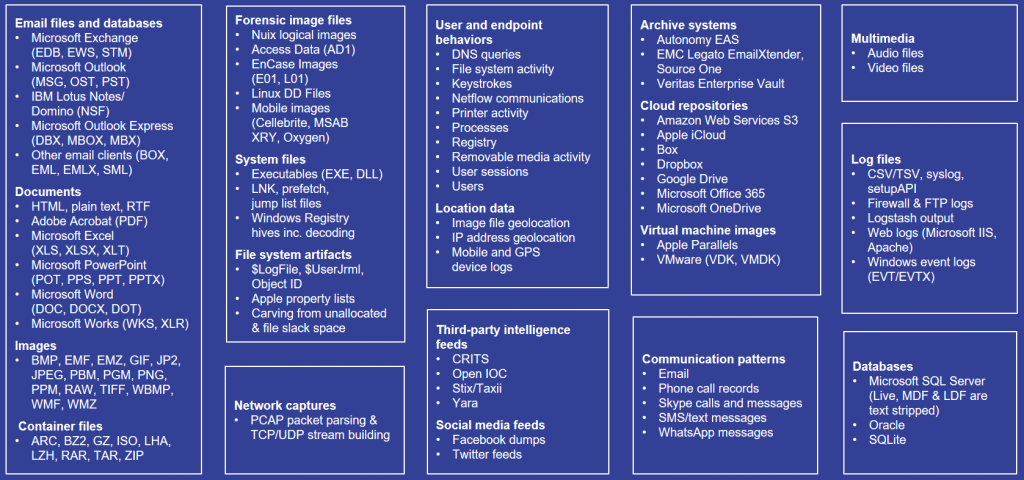
How exactly is this possible? It all comes down to the secret sauce in the Nuix Engine and how our users decide to present the data for their organizational use cases. For example, in preparation for litigation, it may be a good idea to perform a proportionality analysis to determine the depth of the extraction required.
Doug Austin from eDiscovery Today recently referenced [5] a Craig Ball blog [5] in which the topic of advanced settings are considered . Whether you’re preparing data for litigation, beginning your forensic investigation, or working on data governance initiatives, Nuix has you covered with a wide range of options.
Below is a screenshot of Nuix Workstation data processing settings, which enable the aforementioned benefits. Specifically, I’d like to call out:
- Basic Index Settings – Control the depth of details
- Full content (text), metadata, and the family/hierarchy of files
- Flexibility to control storing the item’s binary and other settings to enable near duplicates, topic modelling, and identifying sensitive data.
- Forensic Settings – Control the level of forensic vigour
- Recovering deleted files, working with slack space, and file carving
- Creating photo thumbnails, skin-tone analysis, face detection, and deep learning.
- Advanced Index Settings – Enrich your index with additional options specific to use-cases
- Grouping families together for search, enabling exact queries, leverage stemming, or stop words
- Controlling the digests and hash calculations
- Streamlining imaging, OCR, and metadata workflow.
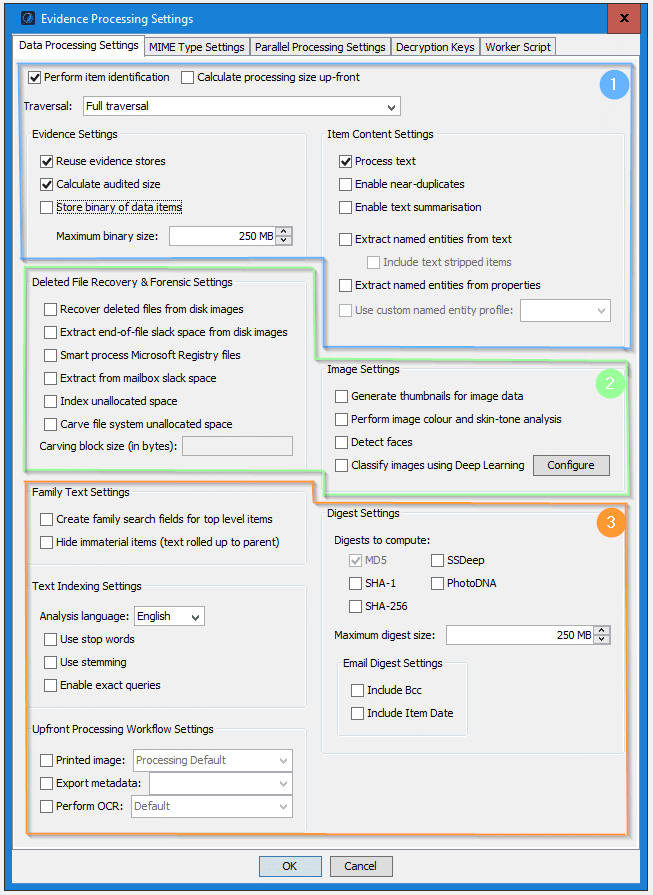
Once you’re locked in with the appropriate data processing settings (which can be turned into an easily reusable template) buckle your seatbelt! Nuix can consume data of all sizes and take advantage of the horsepower it’s running on to scale from GBs per hour to TBs per day.
In fact, one of my new clients in the pharmaceutical space was able to process a rather large and complex data set with Nuix in 36 hours as opposed to its older technology, which couldn’t even move the needle after close to 1.5 months.
To make it clear, the client recognized an immediate ROI within days of implementing Nuix!
Making $@#$ searchable
“While processing is a key capability of the Nuix Engine, it is so much more powerful,” said Nuix CTO Stephen Stewart. “The Nuix Engine’s ability consume all 10 dimensions of data, normalize all the text and metadata into a consistent schema is amazing. Said more straight—Nuix makes $@#$ searchable.”
Stephen is absolutely right! The fun really starts after the data has been processed and it is normalized and fully searchable. Nuix provides simple yet powerful ways to prepare the data for downstream analysis and review.
Again, regardless of use case, Nuix has you covered:
- Comprehensive data reduction techniques that include keyword (and advanced/complex) searches, threading, file types, date ranges, de-NISTing, and more
- Granular deduplication by item, family, custodian, and even more customizable logic
Early data assessment including number crunching, pivot reports, and metadata.
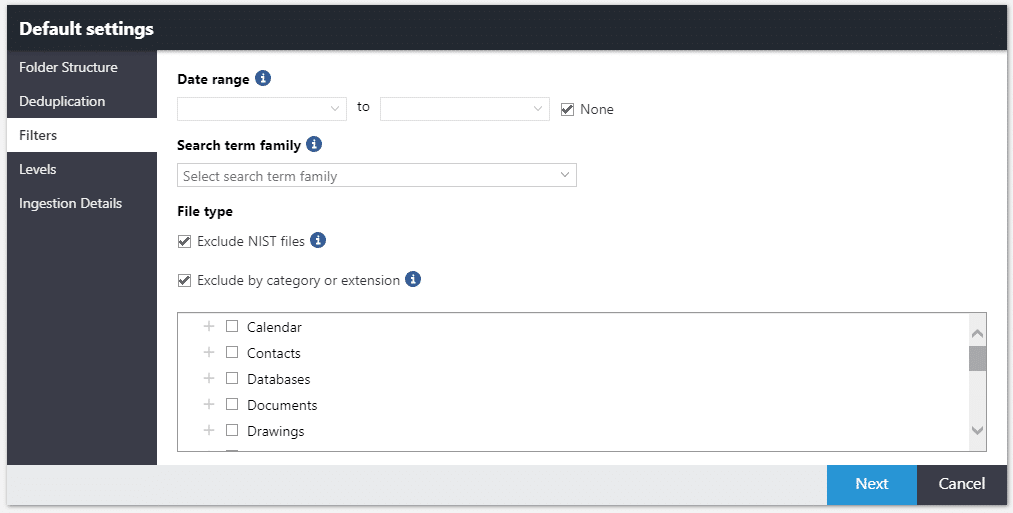
Wrapping up and looking ahead
Between the volume, velocity, and variety that the Nuix Engine brings to the table to quickly consume various types of data, making it fully enriched and searchable, coupled with the ability to filter and cull hundreds of different ways, it should be pretty apparent why building an unstructured data solution around the Nuix platform makes sense.
Looking back at the some of the processing requirements, here are a few ways Nuix can help solve these challenges:
- Get to the big picture quickly and comprehensively, answer the fundamental questions of any matter, and make early data/case assessments with all the facts at your fingertips.
- Mitigate risks with consistent, repeatable, and forensically defensible process across each item and data source.
- Empower your experts with insights like no other technology, revealing and contextualizing the stories hidden in the data.
- Capture the content, metadata, and context of each item for more than 1,000 file formats and turn it into meaningful information.
- Use a single platform for all your use cases ranging from litigation, forensic investigations, governance, risk, compliance, incident response, and more.
Taking the critical endpoint data capture using Nuix Endpoint (covered in Part 2), we can layer it next to additional unstructured data sources to be fully processed and searchable using the Nuix Engine. Regardless of data type or size, Nuix is flexible enough to scale based on your organisation’s requirements.
Stayed tuned for Part Four, where I’ll continue our unstructured data solution journey and understand how the data that’s been collected and processed can be explored and analysed using our software.